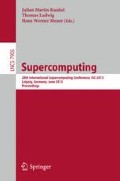Abstract
Extracting maximum performance of multi-core architectures is a difficult task primarily due to bandwidth limitations of the memory subsystem and its complex hierarchy. In this work, we study the implications of fork-join and data-driven execution models on this type of architecture at the level of task parallelism. For this purpose, we use a highly optimized fork-join based implementation of the FMM and extend it to a data-driven implementation using a distributed task scheduling approach. This study exposes some limitations of the conventional fork-join implementation in terms of synchronization overheads. We find that these are not negligible and their elimination by the data-driven method, with a careful data locality strategy, was beneficial. Experimental evaluation of both methods on state-of-the-art multi-socket multi-core architectures showed up to 22% speed-ups of the data-driven approach compared to the original method. We demonstrate that a data-driven execution of FMM not only improves performance by avoiding global synchronization overheads but also reduces the memory-bandwidth pressure caused by memory-intensive computations.
Access this chapter
Tax calculation will be finalised at checkout
Purchases are for personal use only
Preview
Unable to display preview. Download preview PDF.
References
Dehnen, W.: A hierarchical o(n) force calculation algorithm. Journal of Computational Physics 179(1), 27–42 (2002)
Chaillat, S., Bonnet, M., Semblat, J.F.: A multi-level fast multipole bem for 3-d elastodynamics in the frequency domain. Computer Methods in Applied Mechanics and Engineering 197, 4233–4249 (2008)
Yokota, R., Narumi, T., Barba, L.A., Yasuoka, K.: Petascale turbulence simulation using a highly parallel fast multipole method (2011)
Chandramowlishwaran, A., Williams, S., Oliker, L., Lashuk, I., Biros, G., Vuduc, R.: Optimizing and tuning the fast multipole method for state-of-the-art multicore architectures. In: 2010 IEEE International Symposium on Parallel Distributed Processing (IPDPS), pp. 1–12 (April 2010)
Chandramowlishwaran, A., Madduri, K., Vuduc, R.: Diagnosis, tuning, and redesign for multicore performance: A case study of the fast multipole method. In: Proceedings of the 2010 ACM/IEEE International Conference for High Performance Computing, Networking, Storage and Analysis, SC 2010, pp. 1–12. IEEE Computer Society, Washington, DC (2010)
Augonnet, C., Thibault, S., Namyst, R.: StarPU: a Runtime System for Scheduling Tasks over Accelerator-Based Multicore Machines. Rapport de Recherche RR-7240, INRIA (March 2010)
Duran, A., Ayguade, E., Badia, R.M., Labarta, J., Martinell, L., Martorell, X., Planas, J.: Ompss: a proposal for programming heterogeneous multi-core architectures. Parallel Processing Letters, 173–193 (2011)
YarKhan, A., Kurzak, J., Dongarra, J.: Quark users’ guide: Queueing and runtime for kernels. Technical report, University of Tennessee Innovative Computing Laboratory (April 2011)
Barnes, J., Hut, P.: A hierarchical O(N log N) force-calculation algorithm. Nature 324(6096), 446–449 (1986)
Greengard, L.F.: The rapid evaluation of potential fields in particle systems. PhD thesis, New Haven, CT, USA, AAI8727216 (1987)
Ying, G.L., Biros, Zorin, D., Langston, H.: A new parallel kernel-independent fast multipole method. In: Supercomputing, 2003 ACM/IEEE Conference, p. 14 (November 2003)
Ying, L., Biros, G., Zorin, D.: A kernel-independent adaptive fast multipole algorithm in two and three dimensions (2003)
Greengard, L.: The Rapid Evaluation of Potential Fields in Particle Systems, vol. 52. MIT Press (1988)
McCalpin, J.D.: Memory bandwidth and machine balance in current high performance computers. IEEE Computer Society Technical Committee on Computer Architecture TCCA Newsletter, 19–25 (1995)
Knüpfer, A., Brunst, H., Doleschal, J., Jurenz, M., Lieber, M., Mickler, H., Müller, M.S., Nagel, W.E.: The Vampir Performance Analysis Tool-Set. In: Resch, M., Keller, R., Himmler, V., Krammer, B., Schulz, A. (eds.) Tools for High Performance Computing, pp. 139–155. Springer, Heidelberg (2008)
Brunst, H., Knüpfer, A.: Vampir. In: Encyclopedia of Parallel Computing. Springer (2011)
Drongowski, P.J.: Basic performance measurements for amd athlontm 64, amd opterontm and amd phenomtm processors (September 25, 2008)
Intel xeon processor e5-2600 product family uncore performance monitoring guide (March 2012)
Williams, S., Waterman, A., Patterson, D.: Roofline: an insightful visual performance model for multicore architectures. Commun. ACM 52, 65–76 (2009)
Bergstrom, L.: Measuring numa effects with the stream benchmark (2011)
Agullo, E., Bramas, B., Coulaud, O., Darve, E., Messner, M., Takahashi, T.: Pipelining the fast multipole method over a runtime system (2012)
Pericas, M., Amer, A., Fukuda, K., Maruyama, N., Yokota, R., Matsuoka, S.: Towards a dataflow fmm using the ompss programming model. In: 136th IPSJ Conference on High Performance Computing
Taura, K., Yokota, R., Maruyama, N.: A task parallelism meets fast multipole methods. In: Proceedings of SCALA 2012 (November 2012)
Datta, K., Kamil, S., Williams, S., Oliker, L., Shalf, J., Yelick, K.: Optimization and performance modeling of stencil computations on modern microprocessors (2009)
Williams, S., Oliker, L., Vuduc, R., Shalf, J., Yelick, K., Demmel, J.: Optimization of sparse matrix-vector multiplication on emerging multicore platforms. In: Proceedings of the 2007 ACM/IEEE Conference on Supercomputing, SC 2007, 38:1–38:12. ACM, New York (2007)
Author information
Authors and Affiliations
Editor information
Editors and Affiliations
Rights and permissions
Copyright information
© 2013 Springer-Verlag Berlin Heidelberg
About this paper
Cite this paper
Amer, A., Maruyama, N., Pericàs, M., Taura, K., Yokota, R., Matsuoka, S. (2013). Fork-Join and Data-Driven Execution Models on Multi-core Architectures: Case Study of the FMM. In: Kunkel, J.M., Ludwig, T., Meuer, H.W. (eds) Supercomputing. ISC 2013. Lecture Notes in Computer Science, vol 7905. Springer, Berlin, Heidelberg. https://doi.org/10.1007/978-3-642-38750-0_19
Download citation
DOI: https://doi.org/10.1007/978-3-642-38750-0_19
Publisher Name: Springer, Berlin, Heidelberg
Print ISBN: 978-3-642-38749-4
Online ISBN: 978-3-642-38750-0
eBook Packages: Computer ScienceComputer Science (R0)

